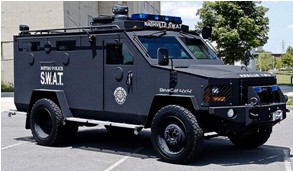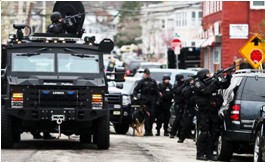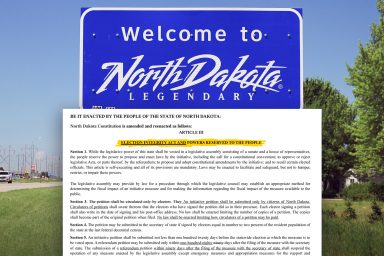WhoWhatWhy first brought you the story of the disturbing trend of police departments arming themselves with surplus weapons from the battlefields of Afghanistan and Iraq to patrol Main Street, U.S.A. Others are finally picking up on this explosion of police firepower.
American police departments are the lucky beneficiaries of the huge stock of used wartime weapons now coming back from the battlefields in Afghanistan and Iraq, a story WhoWhatWhy first brought you in February.
The idea that everyday police work requires mine-resistant armored vehicles and military-grade assault rifles is something we questioned in our piece, and now others including The New York Times and the American Civil Liberties Union are picking up on the story, too.
The ACLU this week released a report examining police militarization that estimates that at least 500 police departments have been given MRAPs—Mine Resistant Ambush Protected—vehicles under a U.S. Department of Defense program. Those machines were built to withstand rocket-propelled grenades, assault rifle fire and roadside bombs—the kind of risks found in Afghanistan and Iraq, not Arkansas or Illinois.
The report found that MRAPs and other weapons of war were being deployed by SWAT teams—paramilitary police units originally designed to rescue hostages or deal with crazed shooters—primarily to execute search warrants in low-level drug investigations. Further, SWAT teams used battering rams to enter homes nearly two-thirds of the time.
The justification police departments most often give for needing these kinds of weapons and tools is that officer safety is paramount. The ACLU found that concern to be overblown:
The use of SWAT teams to serve search warrants could perhaps be justified if there were reason to believe that these situations truly presented a genuine threat to officer safety, but that did not appear to be the case from the documents that the ACLU examined; of the incidents in which officers believed a weapon would be present, a weapon (typically a firearm such as a handgun but rarely an assault rifle) was actually found at the scene in only 35 percent of cases.
Even more disconcerting is the fact that most of this kind of police activity is happening without any real public oversight. Only two states, Utah and Maryland, have laws requiring police departments to regularly report on their use of SWAT teams, and the Maryland law expires this year.
We repost our story, first published on Feb. 17, below in its entirety to give you an idea of what police are putting in their arsenals.
***
If you’re a small town or perhaps a university security department, the US Department of Defense has got a deal for you!
Thanks to the ending of the Iraq War, and the winding down of the war in Afghanistan, the Pentagon has 11,000 heavily armored vehicles that it has no use for. Called MRAPs—Mine-Resistant Ambush Protected—they are designed to protect against AK-47s, rocket-propelled grenades and IEDs. And as pitchman Paul Richards used to say of the ’69 Pontiac Firebird, “They’re practically giving them away!”
Correction, they are giving them away.
All a local police department has to do to get itself an 18-ton MRAP—which originally cost taxpayers between $400,000-$700,000 complete with gun turret and bullet-proof windows—is send a few cops to pick it up and pay for the gas.
There are a few downsides: the things get only five miles to the gallon, can’t go over most bridges, or under them, and have a nasty habit of tipping over on rough terrain.
For departments that find them too unwieldy, the Homeland Security Department is also offering grants to communities so they can buy smaller Lenco BearCats, lighter armored military-style vehicles that run about $280,000.
Since last summer, police departments across the country have taken possession of 165 DOD surplus MRAPs, and there are another 731 requests for the 14-foot-high vehicles. Even Ohio State University police got their hands on one, saying it would provide a “police presence” at football games. Most of the rest of the vehicles to date have gone to smaller community police forces—everywhere from Farmington, NM (pop. 45,000) to Hamburg Village, NY (pop. 9,500).
The number of BearCats purchased with Homeland Security grants isn’t readily available, but they were on conspicuous display in and around Boston last year during the metro-area-wide martial law lockdown while police and National Guard searched for Dzhokhar Tsarnaev, the wounded and unarmed 19-year-old suspect in the Boston Marathon bombing.
For the most part, Americans don’t seem to question the use of military vehicles by their local police, but some communities are starting to object. In Concord, New Hampshire, for instance, 1500 residents last fall signed a petition opposing their town’s use of a $258,000 federal Homeland Security grant to purchase a BearCat for the local police department.
The Concord Monitor reported that most of those opposing the purchase said they feared further militarization of their local police. Despite the opposition, the town government went ahead with the acquisition anyway.
Beating the MRAP
Enter State Representative J.R. Hoell, a libertarian Republican who represents Dunbarton, NH, just outside of Concord. Hoell recently introduced a bill, the Police Equipment and Community Engagement (PEACE) Act, in the state legislature.
The proposed legislation is now in committee. If it’s passed and signed into law by the governor, state and municipal agencies in New Hampshire will be barred from buying or even accepting free offers of “military style equipment” for police use, except with the approval of the assembled citizenry at a public town meeting.
That prohibition would include not just MRAPS and BearCats, but also things like fully automatic weapons or anything that is not “available in an open commercial market.” These restrictions would not apply to the National Guard.
Rep. Hoell spoke to us about his bill.
WhoWhatWhy: Why did you introduce this bill?
Rep. Hoell: I introduced the bill because the citizens of Concord were overwhelmingly opposed to their police department having MRAP vehicles and it was ordered anyway. I don’t see any reason for police to have armored vehicles, or even fully automatic weapons.
WhoWhatWhy: Why are you opposed to police having military equipment?
Rep. Hoell: The role of the state is to make sure the citizens have the best law enforcement and not one that’s overly militarized. Whatever happened to police wearing blue? Now they are dressed in black, head to toe, and when they go to serve warrants at people’s homes, they break the door down, and they wear masks.
WhoWhatWhy: Why the masks?
Rep. Hoell: I don’t know, maybe it’s a military thing. But it is not community policing.
WhoWhatWhy: What kind of support are you getting for this bill?
Hoell: I’m getting support from citizens of the state across the political spectrum.
WhoWhatWhy: Why do you think police in this country are becoming increasingly militarized?
Rep. Hoell: I can’t speculate about why this is happening, but I know that the citizens don’t want it. It needs to stop.
[box]WhoWhatWhy plans to continue doing this kind of groundbreaking original reporting. You can count on it. But can we count on you? We cannot do our work without your support.
Please click here to donate; it’s tax deductible. And it packs a punch.[/box]






